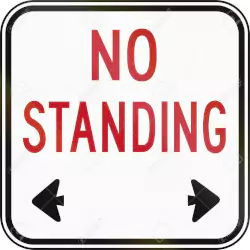No Standing Sign
-
 CDE
CDE - Update on. 23 Apr, 2025

Introduction
In Canada’s urban centers, traffic flow and pedestrian safety are managed using strict stopping and parking rules. One of the more misunderstood signs is the No Standing sign. While it looks similar to “No Parking,” it carries stricter restrictions, and knowing the difference is essential for the Ontario G1 driving test.
What Does the No Standing Sign Mean?
The No Standing sign indicates that vehicles are not allowed to stop or stand in the marked area—even temporarily—unless actively picking up or dropping off passengers.
Key features:
-
Bold red lettering on a white background
-
Double arrows showing the restricted zone’s direction or span
-
Applies to both sides if arrows point both ways
This rule is more restrictive than No Parking and No Stopping zones in certain contexts.
Where Are No Standing Signs Typically Placed?
Common locations include:
-
Downtown areas with high traffic and limited curb space
-
Transit stops or taxi stands
-
School zones and loading zones
-
Busy pedestrian crosswalks or intersections
They are used to keep the curb area clear to ensure safety and reduce traffic congestion.
How Should Drivers Respond to This Sign?
Drivers must not stop or wait in the area unless they are:
-
Immediately dropping off or picking up passengers
-
Not unloading or loading goods or waiting for someone
When approaching this sign:
-
Do not idle or double park
-
Avoid using your hazard lights to “wait”—this is still a violation
-
Move along immediately after passenger exchange
Violating this sign can result in:
-
Fines (often over $100 in Ontario cities)
-
Towing of your vehicle
-
Demerit points if it causes an obstruction or accident
Visual Representation of the Sign
The sign clearly states “NO STANDING” in red text, often with black arrows pointing left, right, or both directions—defining the zone where stopping is not allowed.
Conclusion
Understanding the No Standing sign is crucial for both everyday drivers and G1 test candidates. It ensures clear access for emergency, pedestrian, and transit operations. Respecting this sign contributes to better traffic management and safer roadways in Canadian cities.

Please Comment Below